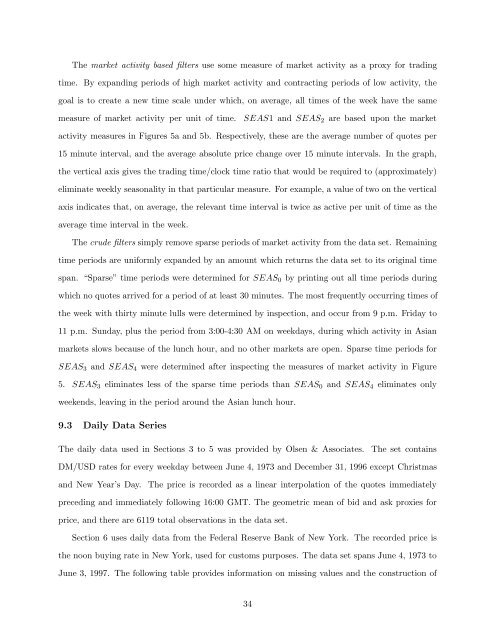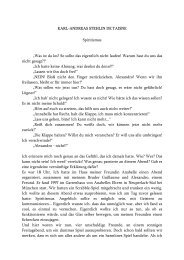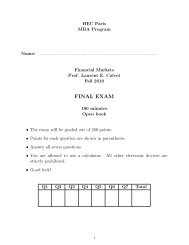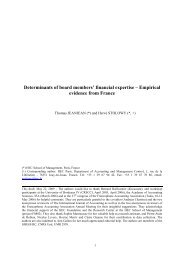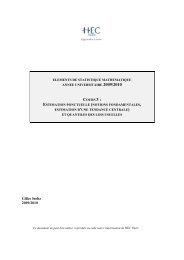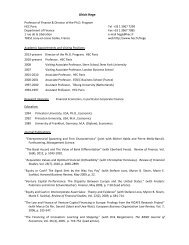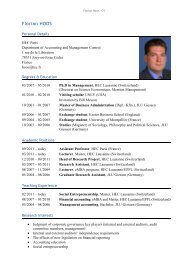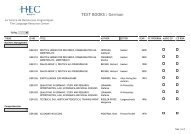Multifractality of US Dollar/Deutsche Mark Exchange Rates - Studies2
Multifractality of US Dollar/Deutsche Mark Exchange Rates - Studies2
Multifractality of US Dollar/Deutsche Mark Exchange Rates - Studies2
You also want an ePaper? Increase the reach of your titles
YUMPU automatically turns print PDFs into web optimized ePapers that Google loves.
The market activity based filters use some measure <strong>of</strong> market activity as a proxy for trading<br />
time. By expanding periods <strong>of</strong> high market activity and contracting periods <strong>of</strong> low activity, the<br />
goal is to create a new time scale under which, on average, all times <strong>of</strong> the week have the same<br />
measure <strong>of</strong> market activity per unit <strong>of</strong> time. SEAS1 andSEAS2 are based upon the market<br />
activity measures in Figures 5a and 5b. Respectively, these are the average number <strong>of</strong> quotes per<br />
15 minute interval, and the average absolute price change over 15 minute intervals. In the graph,<br />
the vertical axis gives the trading time/clock time ratio that would be required to (approximately)<br />
eliminate weekly seasonality in that particular measure. For example, a value <strong>of</strong> two on the vertical<br />
axis indicates that, on average, the relevant time interval is twice as active per unit <strong>of</strong> time as the<br />
average time interval in the week.<br />
The crude filters simply remove sparse periods <strong>of</strong> market activity from the data set. Remaining<br />
time periods are uniformly expanded by an amount which returns the data set to its original time<br />
span. “Sparse” time periods were determined for SEAS0 by printing out all time periods during<br />
which no quotes arrived for a period <strong>of</strong> at least 30 minutes. The most frequently occurring times <strong>of</strong><br />
the week with thirty minute lulls were determined by inspection, and occur from 9 p.m. Friday to<br />
11 p.m. Sunday, plus the period from 3:00-4:30 AM on weekdays, during which activity in Asian<br />
markets slows because <strong>of</strong> the lunch hour, and no other markets are open. Sparse time periods for<br />
SEAS3 and SEAS4 were determined after inspecting the measures <strong>of</strong> market activity in Figure<br />
5. SEAS3 eliminates less <strong>of</strong> the sparse time periods than SEAS0 and SEAS4 eliminates only<br />
weekends, leaving in the period around the Asian lunch hour.<br />
9.3 Daily Data Series<br />
The daily data used in Sections 3 to 5 was provided by Olsen & Associates. The set contains<br />
DM/<strong>US</strong>D rates for every weekday between June 4, 1973 and December 31, 1996 except Christmas<br />
and New Year’s Day. The price is recorded as a linear interpolation <strong>of</strong> the quotes immediately<br />
preceding and immediately following 16:00 GMT. The geometric mean <strong>of</strong> bid and ask proxies for<br />
price, and there are 6119 total observations in the data set.<br />
Section 6 uses daily data from the Federal Reserve Bank <strong>of</strong> New York. The recorded price is<br />
the noon buying rate in New York, used for customs purposes. The data set spans June 4, 1973 to<br />
June 3, 1997. The following table provides information on missing values and the construction <strong>of</strong><br />
34


